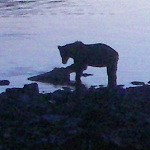
In 2010, brown bears in Glacier Bay received a four month buffet in the form of a 41 foot dead humpback whale that washed up on a beach in the West Arm and persisted throughout the summer. While the cause of the whale's death is unknown, the carcass provided a rare opportunity for bears in this area to gorge on fat and protein for several months, and also a rare treat for visitors and locals to observe and photograph bears, birds, and wolves at the carcass. Scientists embraced this incredible opportunity and documented scavenging activities associated with this large food source with the use of two remote cameras attached to trees overlooking the carcass. One camera took a photo every 15 minutes for over 90 days. The other camera was equipped with a motion sensor that was triggered by animals transiting the area. Between the two cameras, the researchers gathered almost 10,000 photos! The remote cameras documented some amazing things:
Blubber Lovers...Year TWO 
Scavengers On Camera |
Last updated: September 24, 2024

